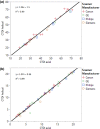The helically-acquired CTDIvol as an alternative to traditional methodology
- PMID: 32519415
- PMCID: PMC7484853
- DOI: 10.1002/acm2.12944
The helically-acquired CTDIvol as an alternative to traditional methodology
Abstract
Purpose: Most clinical computed tomography (CT) protocols use helical scanning; however, the traditional method for CTDIvol measurement replaces the helical protocol with an axial scan, which is not easily accomplished on many scanners and may lead to unmatched collimation settings and bowtie filters. This study assesses whether CTDIvol can be accurately measured with a helical scan and determines the impact of pitch, collimation width, and excess scan length.
Methods: CTDIvol was measured for 95 helical protocols on 31 CT scanners from all major manufacturers. CTDIvol was measured axially, then again helically, with the scan range set to the active area of the pencil chamber seen on the localizer image. CTDIvol measurements using each method were compared to each other and to the scanner-displayed CTDIvol . To test the impact of scan length, the study was repeated on four scanners, with the scan range set to the phantom borders seen on the localizer.
Results: It was not possible to match the collimation width between the axial and helical modes for 12 of the 95 protocols tested. For helical and axial protocols with matched collimation, the difference between the two methods averaged below 1 mGy with a correlation of R2 = 0.99. The difference between the methods was not statistically significant (P = 0.81). The traditional method produced four measurements that differed from the displayed CTDIvol by >20%; no helical measurements did. The accuracy of the helical CTDIvol was independent of protocol pitch (R2 = 0.0) or collimation (R2 = 0.0). Extending the scan range to the phantom borders increased the measured CTDIvol by 2.1%-9.7%.
Conclusion: There was excellent agreement between the two measurement methods and to the displayed CTDIvol , without protocol or vendor dependence. The helical CTDIvol measurement can be accomplished more easily than the axial method on many scanners and is reasonable to use for QC purposes.
Keywords: CTDI; CTDIvol; computed tomography; helical acquisition.
© 2020 The Authors. Journal of Applied Clinical Medical Physics published by Wiley Periodicals, Inc. on behalf of American Association of Physicists in Medicine.
Conflict of interest statement
No conflict of interest.
Figures






References
-
- Bauhs JA, Vrieze TJ, Primak AN, Bruesewitz MR, McCollough CH. CT dosimetry: comparison of measurement techniques and devices. Radiographics. 2008;28:245–253. - PubMed
-
- Shope TB, Gagne RM, Johnson GC. A method for describing the doses delivered by transmission x‐ray computed tomography. Med Phys. 1981;8:488–495. - PubMed
-
- AAPM Report No. 96: The Measurement, Reporting, and Management of Radiation Dose in CT. College Park, MD: American Association of Physicists in Medicine; 2007.
-
- Performance Standards for Ionizing Radiation Emitting Products. In: FDA, ed. 21 C.F.R. 1020.33. Rev. April 1, 2018 ed.
-
- Provision for alternate measure of the computed tomography dose index (CTDI) to assure compliance with the dose information requirements of the federal performance standard for computed tomography. FDA Center for Devices and Radiological Health; 2006.

